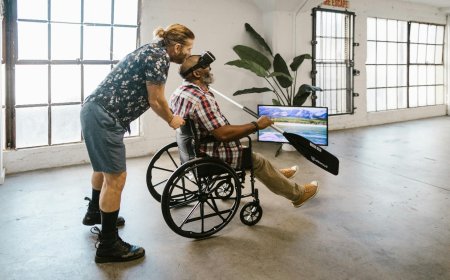Treating Phobias and PTSD with Virtual Reality (VR) Therapy

Emerging as a revolutionary tool in contemporary mental health treatment, Virtual Reality Therapy (VRT) presents creative ways to treat phobias and PTSD. This method offers a safe and efficient approach to facing anxiety and processing traumatic events by submerging patients into regulated, computer-generated surroundings. VRT is rising in popularity as studies confirm its effectiveness as other therapeutic modalities are under more and more scrutiny.
Understanding Virtual Reality Therapy
Using immersive technology, virtual reality therapy creates controlled environment simulations of real-world events. Patients wear VR headsets that carry them into virtual environments catered to their treatment needs. Engagement of patients in exposure therapy, a psychological method whereby people are progressively exposed to anxiety-inducing situations, is the aim. Unlike conventional exposure therapy, which depends on real-life or imagined situations, VRT generates rich, interactive experiences that feel real but remain secure.
Because it lets therapists instantly change the amount of exposure, this method is beneficial for treating phobias and PTSD. A person who suffers from a phobia of flying, for example, might start by sitting in a virtual airplane on the ground and then work towards a simulated takeoff. In a similar vein, PTSD sufferers can revisit horrific memories under control, allowing them to sort through their feelings free from the dangers of actual exposure.
Treating Phobias with Virtual Reality
Strong, illogical dread of objects or circumstances that can seriously affect daily living are known as phobias. Though this procedure might be logistically difficult and emotionally taxing, traditional treatments usually entail slow exposure to the feared stimulus. By building realistic but regulated environments where patients may face their anxieties at their speed, VRT solves these constraints.
For instance, as therapy advances, someone with arachnophobia—fear of spiders—may engage with virtual spiders that seem even more lifelike. Over time, this slow desensitization helps to lower anxiety reactions. Studies on VRT's treatment of several phobias—including fear of heights, public speaking, and enclosed spaces—have found it quite successful. Studies show that following VRT for phobias, up to 80% of patients show notable symptom reduction.
VRT's capacity to recreate events that could be challenging or impossible to do in real life is one of its main benefits. For example, in a virtual environment, it is simple to replicate turbulence during a flight or stand on the brink of a high-rise structure. This adaptability improves the therapeutic process and helps to make treatment more affordable and easily available.
Addressing PTSD Through Virtual Reality
A limiting disorder called post-traumatic stress disorder results from either experiencing or observing a horrific event. Symptoms sometimes include emotional numbness, hypervigilance, nightmares, and flashbacks. Although conventional therapies such as exposure therapy and cognitive-behavioral therapy (CBT) have shown success, patients' unwillingness to go back over traumatic experiences can restrict them.
Virtual Reality Therapy presents a special option since it gives patients a safe environment under therapist supervision to face their trauma. Veterans with combat-related PTSD, for instance, can re-experience wartime scenes in a controlled environment using VR systems such as "Virtual Iraq" or "Bravemind." These simulations let patients reinterpret their memories and manage their emotions free from the physical risks connected with real-world contact.
Studies on VRT's efficacy in lowering PTSD symptoms have shown Participants in a study including Iraq and Afghanistan veterans reported a 50% decrease in symptoms following VR-based exposure therapy. Many patients also said they felt more at ease interacting with virtual worlds than with more conventional therapeutic approaches.
VRT's capacity to include sensory inputs outside of vision adds still another benefit. Therapists might use sounds, vibrations, or even odors to improve the realism of virtual environments. This multisensory method facilitates deeper therapeutic involvement by helping emotional reactions be more efficiently triggered.
Advantages of Virtual Reality Therapy
The rise of VRT highlights several key benefits that make it an attractive option for treating phobias and PTSD:
1. Safety and Control: Therapists can construct safe settings in virtual realities where patients may face their anxieties free from actual danger.
2. Customization: Scenarios can be customized to fit specific demands, therefore guaranteeing that therapy advances at a speed suitable for every patient.
3. Accessibility: Finding particular sites or stimuli is one of the logistical difficulties VRT removes from conventional exposure treatment.
4. Cost-Effectiveness: Reducing the demand for travel and physical resources, VRT presents a more reasonably priced substitute for patients and healthcare professionals.
5. Engagement: The immersive nature of VR makes therapy more engaging and less intimidating for many patients.
Challenges and Limitations
Virtual Reality Therapy presents difficulties even if it has several benefits. For some clinics, the first outlay for VR equipment and software can be excessive, therefore restricting access to this technology. Furthermore, even if most patients find VRT to be rather tolerable, some may get motion sickness or discomfort during sessions.
The need for qualified therapists educated in both conventional psychological approaches and the usage of virtual reality technology adds still another restriction. Dealing with these issues will be vital to guarantee general acceptance and efficacy as the profession develops.
The Future of Virtual Reality Therapy
The possible uses of VRT are fast expanding as technology develops. Its application is under investigation by researchers in treating different mental health disorders including addiction, depression, and generalized anxiety disorder (GAD). Further boosting their capacity are innovations like augmented reality (AR) and artificial intelligence (AI) which are also being included in therapeutic platforms.
AI systems may, for instance, examine patient reactions during virtual reality sessions to offer real-time comments or make treatment plan suggestions. AR might, meantime, combine virtual components with real-world surroundings to produce hybrid experiences bridging the imagination and reality gap.
Furthermore, VR hardware is probably going to become a routine component of mental health treatment all around as it gets more reasonably priced and available. From community-based programs tackling public health issues like social anxiety or trauma recovery following natural catastrophes to remote treatment sessions carried out via telehealth platforms—the opportunities are essentially unlimited.
Conclusion
Combining modern technology with evidence-based psychological concepts, virtual reality therapy offers a transforming method of mental health therapy. Its effectiveness in treating PTSD and phobias emphasizes its adaptability as a therapy for handling different mental health problems.
VRT helps people take back control over their lives by offering secure, regulated surroundings where they may face their anxieties and process trauma at their own speed. Virtual Reality Therapy is poised to transform our approach to mental health treatment in the twenty-first century as studies confirm its effectiveness and accessibility increases.
What's Your Reaction?
 Like
0
Like
0
 Dislike
0
Dislike
0
 Love
0
Love
0
 Funny
0
Funny
0
 Angry
0
Angry
0
 Sad
0
Sad
0
 Wow
0
Wow
0































